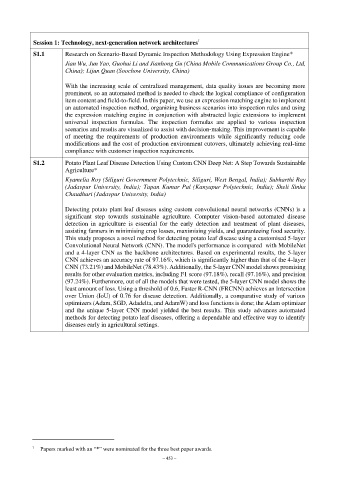Page 497 - Kaleidoscope Academic Conference Proceedings 2024
P. 497
1
Session 1: Technology, next-generation network architectures
S1.1 Research on Scenario-Based Dynamic Inspection Methodology Using Expression Engine*
Jian Wu, Jun Yao, Guohui Li and Jianhong Gu (China Mobile Communications Group Co., Ltd,
China); Lijun Quan (Soochow University, China)
With the increasing scale of centralized management, data quality issues are becoming more
prominent, so an automated method is needed to check the logical compliance of configuration
item content and field-to-field. In this paper, we use an expression matching engine to implement
an automated inspection method, organizing business scenarios into inspection rules and using
the expression matching engine in conjunction with abstracted logic extensions to implement
universal inspection formulas. The inspection formulas are applied to various inspection
scenarios and results are visualized to assist with decision-making. This improvement is capable
of meeting the requirements of production environments while significantly reducing code
modifications and the cost of production environment cutovers, ultimately achieving real-time
compliance with customer inspection requirements.
S1.2 Potato Plant Leaf Disease Detection Using Custom CNN Deep Net: A Step Towards Sustainable
Agriculture*
Kyamelia Roy (Siliguri Government Polytechnic, Siliguri, West Bengal, India); Subharthi Ray
(Jadavpur University, India); Tapan Kumar Pal (Kanyapur Polytechnic, India); Sheli Sinha
Chaudhuri (Jadavpur University, India)
Detecting potato plant leaf diseases using custom convolutional neural networks (CNNs) is a
significant step towards sustainable agriculture. Computer vision-based automated disease
detection in agriculture is essential for the early detection and treatment of plant diseases,
assisting farmers in minimising crop losses, maximising yields, and guaranteeing food security.
This study proposes a novel method for detecting potato leaf disease using a customised 5-layer
Convolutional Neural Network (CNN). The model's performance is compared with MobileNet
and a 4-layer CNN as the backbone architectures. Based on experimental results, the 5-layer
CNN achieves an accuracy rate of 97.16%, which is significantly higher than that of the 4-layer
CNN (73.21%) and MobileNet (78.43%). Additionally, the 5-layer CNN model shows promising
results for other evaluation metrics, including F1 score (97.18%), recall (97.16%), and precision
(97.24%). Furthermore, out of all the models that were tested, the 5-layer CNN model shows the
least amount of loss. Using a threshold of 0.6, Faster R-CNN (FRCNN) achieves an Intersection
over Union (IoU) of 0.76 for disease detection. Additionally, a comparative study of various
optimizers (Adam, SGD, Adadelta, and AdamW) and loss functions is done; the Adam optimizer
and the unique 5-layer CNN model yielded the best results. This study advances automated
methods for detecting potato leaf diseases, offering a dependable and effective way to identify
diseases early in agricultural settings.
1 Papers marked with an “*” were nominated for the three best paper awards.
– 453 –

